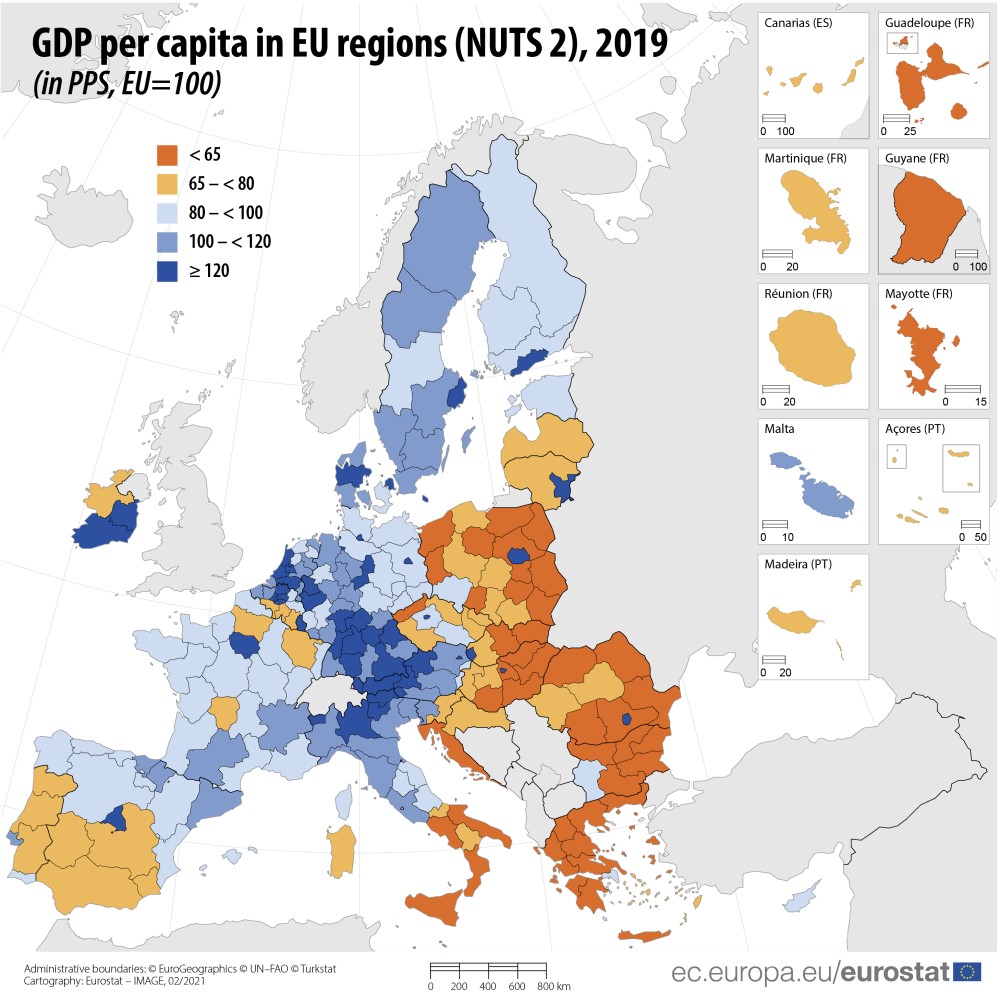Latest Eurostat data: Budapest outperforms Vienna and Berlin in living standards
EnglishAccording to the latest Eurostat data, Budapest is outperforming several important Western European cities in terms of living standards; Prague, Warsaw and Bratislava, however, are still ahead of us.
The Hungarian economy is heavily dominated by the capital city, and the situation has been the same for about a hundred years now. The gap between the capital and the countryside is growing, and the size of this gap is well reflected in recently published statistical data.
Eurostat, the statistical office of the European Union publishes detailed economic data every year to compare living standards in each EU region. The latest figures released last week show the situation for 2019. Eurostat also converts GDP data into a fictitious currency, PPS (Purchasing Power Standard).
This is necessary because there are often large price differences between countries.
The price of a meal at McDonald’s or a brake replacement in your car is obviously not the same in Germany and in Bulgaria. When people are thinking of moving to another country, it often arises that although salaries are incomparably higher in London for example, housing costs are exorbitant, too. PPS completely eliminates the differences in price levels and thus shows the actual standard of living.
In terms of PPS, Budapest is ahead of cities like Vienna, Berlin or Madrid.
Budapest is not the only city in the region to perform so well; the other big cities of Central and Eastern Europe are also doing very well;
Prague, for example, is second only to Luxembourg.
This can be put down to the fact that the economies in our region are typically capital-centric, and the countryside is usually lagging far behind. In contrast, in Germany for example, the standard of living is above the EU average in almost all regions. Berlin is not even in the first place in terms of living standards; the Bavarian region is more highly developed.
GDP per capita in EU capital cities in PPS
|
|
GDP per capita (PPS) |
PPS per capita in relation to the EU average (%) |
|
Luxembourg |
81 000 |
260 |
|
Prague |
63 900 |
205 |
|
Dublin and environs |
63 100 |
202 |
|
Brussels and environs |
63 000 |
202 |
|
Paris and environs |
55 200 |
177 |
|
Amsterdam and environs |
53 000 |
170 |
|
Copenhagen and environs |
51 900 |
167 |
|
Stockholm |
51 900 |
167 |
|
Bratislava and environs |
50 400 |
162 |
|
Warsaw and environs |
49 800 |
160 |
|
Bucharest and environs |
49 700 |
160 |
|
Budapest |
47 100 |
151 |
|
Vienna |
46 400 |
149 |
|
Helsinki and environs |
45 000 |
144 |
|
Madrid and environs |
38 500 |
124 |
|
Berlin |
38 200 |
123 |
|
Rome and environs |
34 300 |
110 |
|
Ljubljana and environs |
33 000 |
106 |
|
Lisbon and environs |
32 000 |
103 |
|
Athens and environs |
28 400 |
91 |
|
Sofia and environs |
27 700 |
89 |
|
Zagreb and environs |
20 500 |
66 |
Source: Eurostat (table does not contain countries where no relevant data was available)
The situation in the countryside looks less favourable for Hungary, with Central Hungary being the only region that exceeds the EU average, followed by Western Transdanubia with 71 percent of the EU average.
The Northern Great Plain and Northern Hungary are two of the poorest regions in the EU.
At the bottom of the list we can mostly find Bulgarian regions, but even a French overseas territory made the list: on the island of Mayotte in the Indian Ocean, the living standards of the roughly 250,000 inhabitants are only 32 percent of the EU average, the same as the Severozapaden region of Bulgaria.
PPS per capita in Hungarian regions in relation to the EU average (%)
|
Budapest |
151 |
|
Central Hungary |
112 |
|
Western Transdanubia |
71 |
|
Central Transdanubia |
67 |
|
Southern Great Plain |
53 |
|
Southern Transdanubia |
50 |
|
Northern Hungary |
49 |
|
Northern Great Plain |
47 |
|
Hungary |
73 |
Source: Eurostat
GDP per capita in EU regions relative to the EU average

